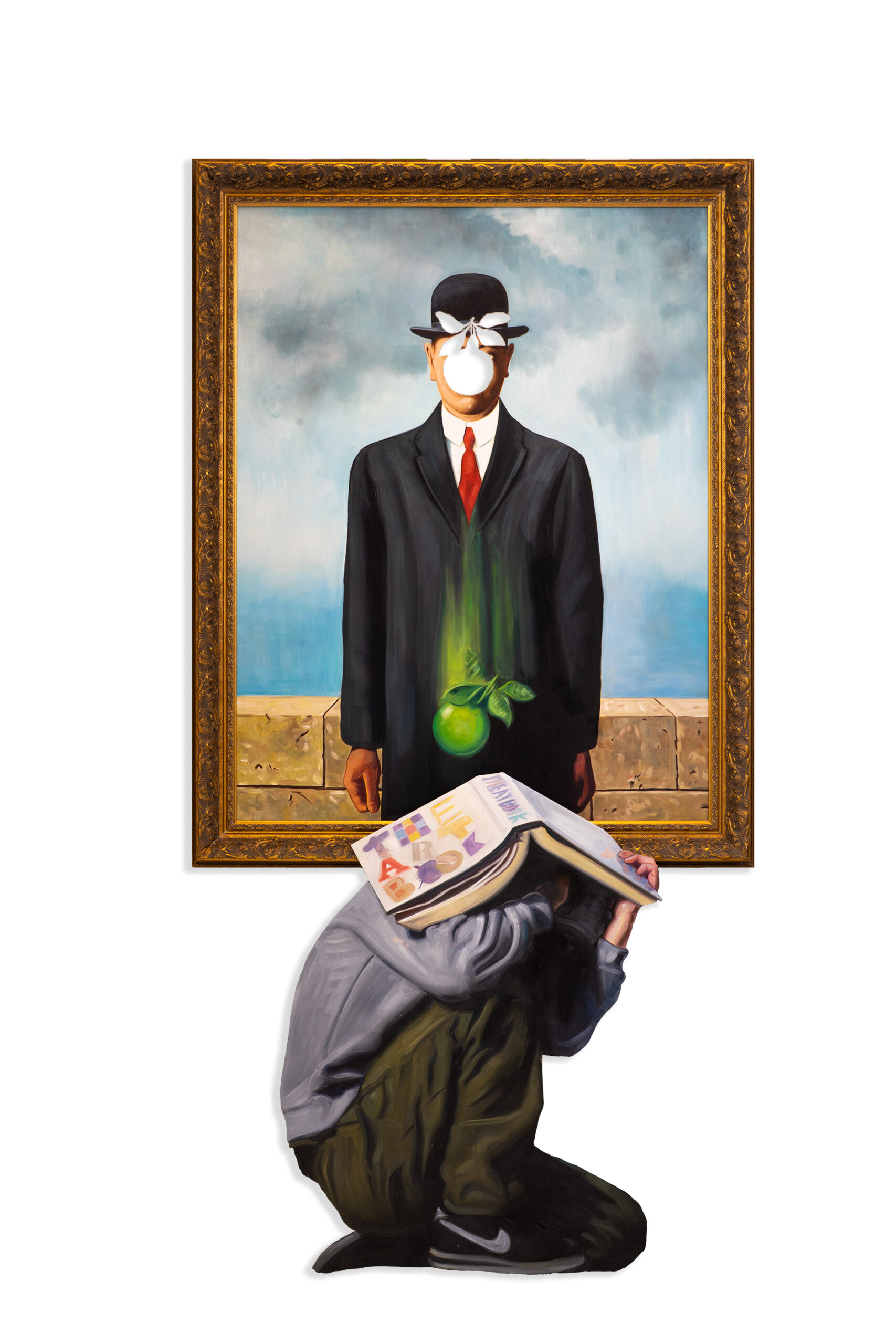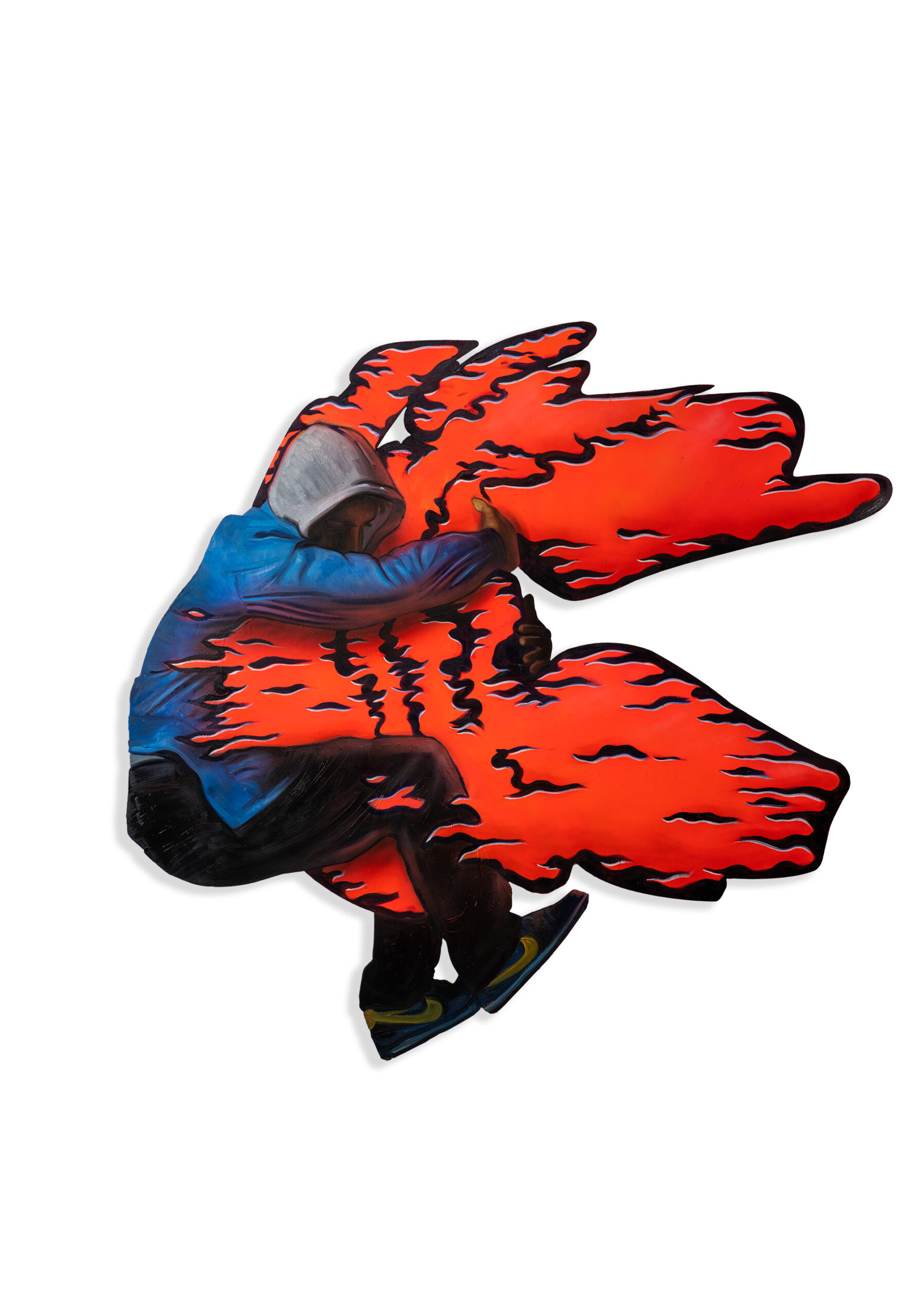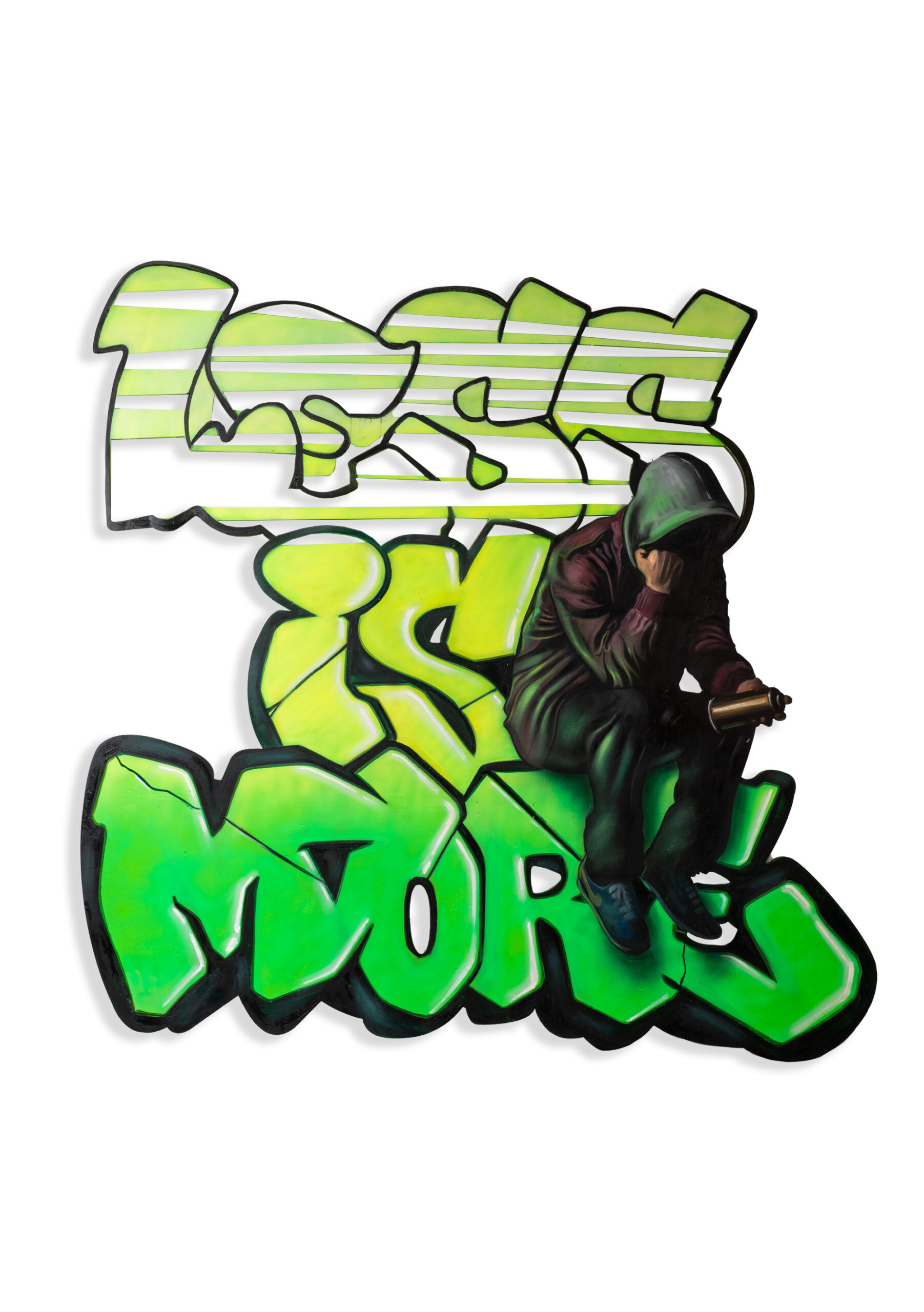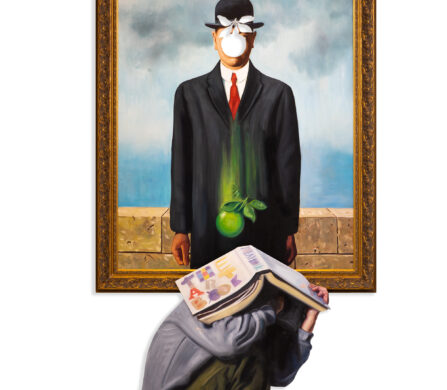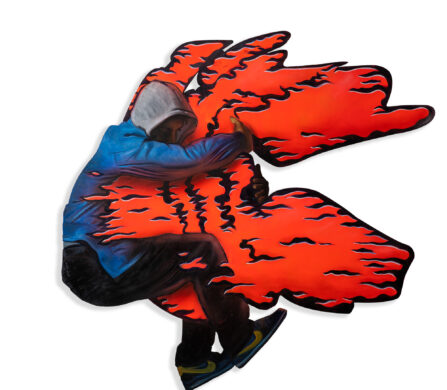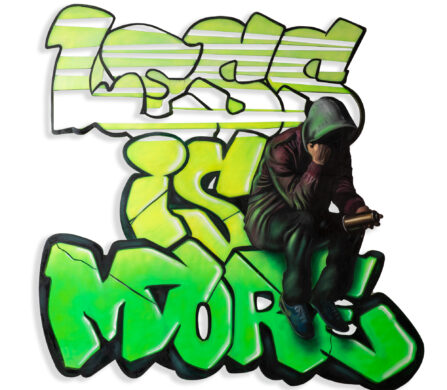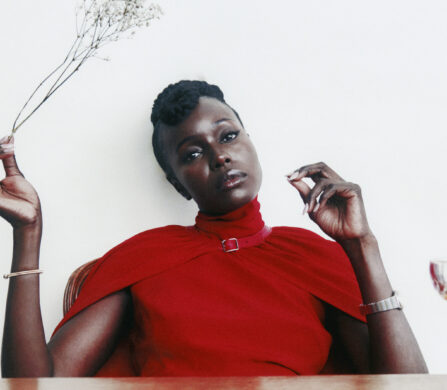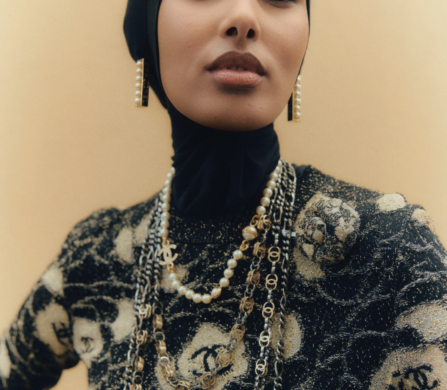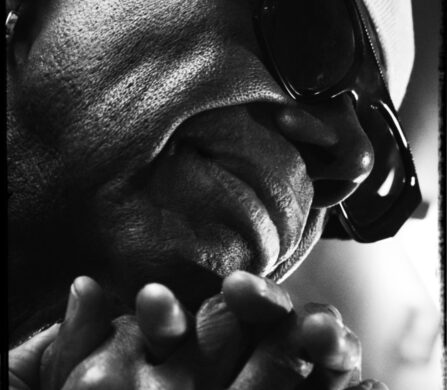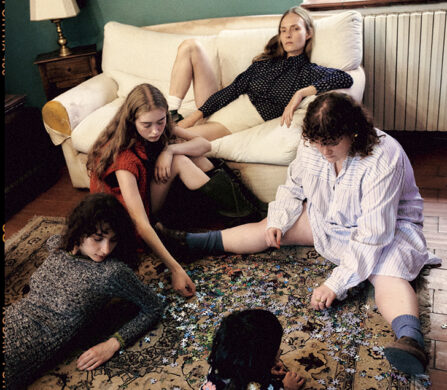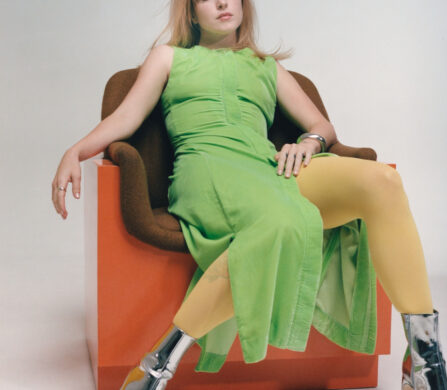
If Hijack, a contemporary artist, could break into any work of art, he would find himself climbing into a sweeping surrealist scene created by René Magritte. He says, “I would then allow Magritte’s imagination to animate those objects [in the painting] and watch them as they freely float across a surreal and borderless landscape where only the impossible is allowed.” Hijack seems to crave infinite space, a desire that manifests in both his street art and fine art. In his recent solo art booth for Art Miami called Think Outside The Frame, his faceless character hijacks classic art pieces with wit and rebellion on one side of the floor, and playfully interacts with graffiti letters on the other side.
On the classic art side, the Hijack character finds himself breaking through the golden frame of Magritte’s “Golconda,” amongst raining men in bowler hats. In another piece, the character shields himself with an art book from a falling green apple in Magritte’s “The Son of Man.” In the booth, Hijack seems to acknowledge that even classic surrealist work is contained in its own mold and pushes boundaries in creating surrealist work out of an already surreal landscape. His “Misfit” piece on the street art side displays his message clearly as he struggles to contain art in a frame.
Hijack tells us that one of his most well-known works, “You’re Never Too Young To Dream Big,” was inspired by others telling him as a child that he was too small to dream up something so big. He knew though that the beauty of a child’s mind is in their boundless imagination, one that has not left him in adulthood. Like in the popular children’s book, Harold and the Purple Crayon, he creates a boundless land for himself and for others to find themselves in. Every world, however, needs an anchor. In the children’s story, the moon was the guiding light, and in Hijack’s story, he calls Los Angeles his “true north.” In the vibrant city’s microcosms, he finds himself with endless inspiration and a thrill around every corner. In our interview with him, he reflects on the first time he experienced an adrenaline rush from creating street art, a feeling that coupled with seeing the blurred stretch of an anonymous smile, is simply enough for him as an artist despite having goals he calls “lofty.” In his Schön! interview, Hijack talks about boundlessness, restriction, and culture!
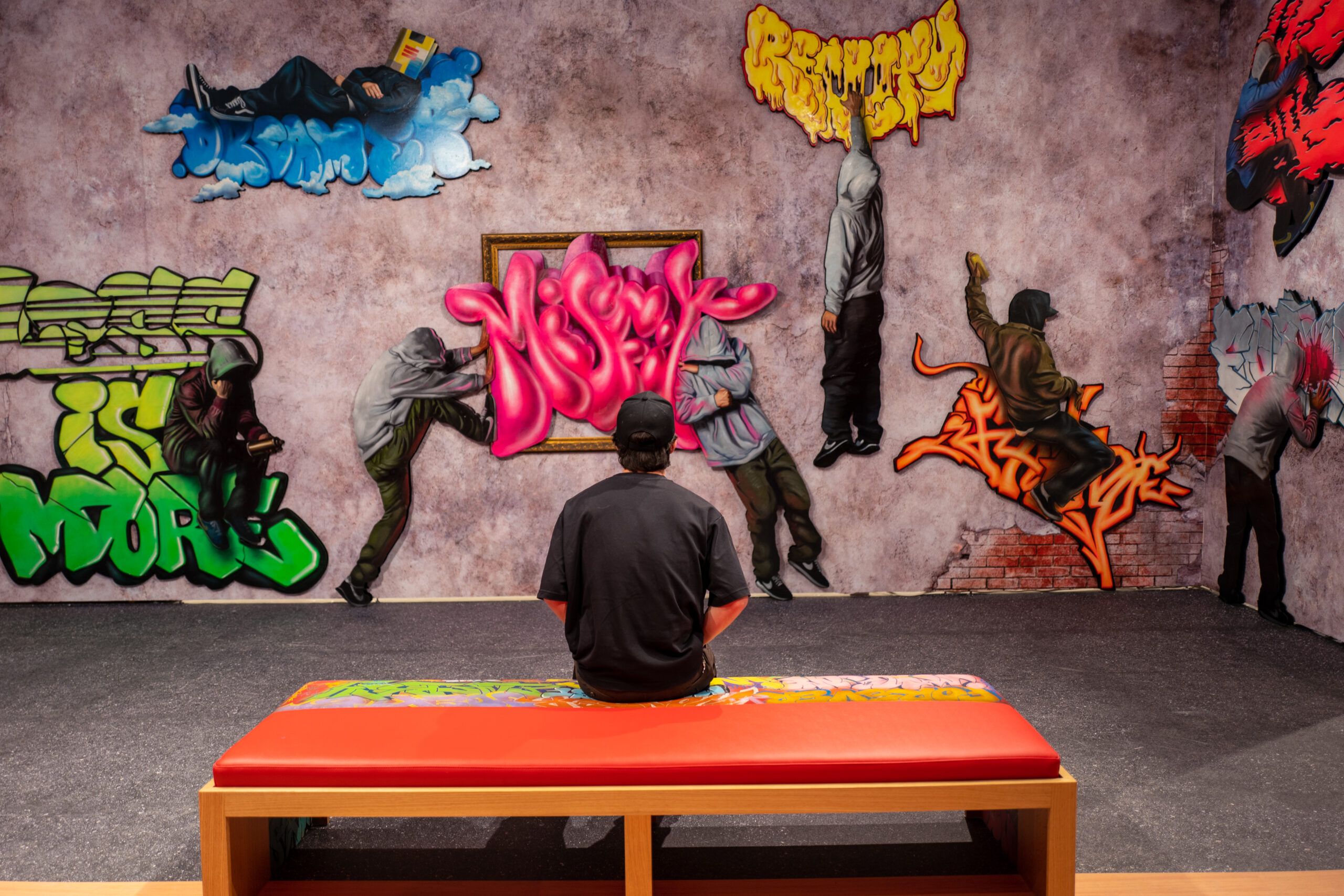
First, Happy New Year! I know you made an Instagram post commemorating 2022, but in your own words, what are some moments that you look back on fondly from this past year?
As the new year begins, I am filled with optimism for what lies ahead. Having experienced a year of creativity and productivity, 2022 yielded much in terms of the hours of work and experimentation which ultimately materialized into a clear vision of my artistic journey. 2022 laid important foundations, and I can now confidently move forward toward any creative project. Last year also felt like a step away from the effects of the pandemic, a time that was both disconcerting and inspiring. More than anything, 2022, and now 2023, is a time to heal from the political and social unrest we have endured over the past few years, a time to hijack the narrative so that we may become a country unified and working towards progress.
A lot of your artwork, particularly your new pieces featured in your solo booth, Think Outside The Frame, shows the Hijack character who, even while being concealed, seems to give off a personality that is witty and curious. Would you consider your work self-referential at all?
My work or character is self-referential to the extent that I’m also a product of this overstimulated digital world. I guess there are things in my work that are inextricably me – in the sense that I do things in a particular way that’s unavoidable and unique to me and my personality. My muse, ‘Hijack,’ however, is an allusion to the struggles of taking control of one’s narrative. Omitting a face emphasizes my message, as this character is relatable to anyone and can be interpreted in a myriad of ways.
I know you personally conceal your identity to a degree, but I wanted to learn a bit more about you as a person, only if you are willing to share. The booth explores dichotomy in art so, what do you think is the most dichotomous thing about your personality?
The most contrasting aspect of my personality is likely the years I spent engaged in street art and its illegal elements. One may presume I am a shady person, intent on ruining properties with no regard for anyone but myself, however, I was captivated by a community within its own culture with its own distinct rules. If one were to become familiar with me, it would become quickly apparent that I am well-adjusted, compassionate to my loved ones, and enjoy all the simple things of life.
Your work often makes a social or political statement and you have worked with several charities over the years. If you were to remove yourself from the fact that you are the creator of your work, what piece(s) of yours do you think would most make you stop and think?
Probably some of the pieces in my show Eco-Librium. The primary intention there was to bring awareness to some of the most pressing issues of our time rather than just to sell. Some of those pieces are pretty dark as a result and they definitely rubbed many the wrong way.
Your Art Miami booth title, Think Outside The Frame, made me think of a piece of street art that I’ve seen before that reads, “Art in a frame is like an eagle in a birdcage.” How do you conceptualize this idea?
It came about naturally. When you work on the street, the intention, planning, and parameters are just different than when working on a gallery show. I felt limited working on your standard framed painting, so I started experimenting, and soon enough my work began to spill outside the frame, hence the name.
On a similar theme, you said in an interview with ART PLUGGED that “the graffiti side of the booth has an underlying rhetoric of conforming to societal norms to reach the same stature as the classics on the gallery side.” That statement interested me because a lot of classic art pieces, at the time of their creation, were considered non-conformist for their time. Like you comment on through other art pieces, time is a construct and perception changes over time. Have you noticed the perception of street art shifting over time? How do you imagine perceptions will continue to shift?
Many things start in the fringes of society and end up becoming mainstream. Hip-hop is a great example of this – beginning in some of New York’s poorest neighbourhoods in the 70s, it has now become a global phenomenon. Similarly, street art and even graffiti have gained a lot of popularity, with some of it being commercialized and embraced by corporations. With social media making these art forms more accessible, they will become even better known. If you want to learn how to do graffiti, [anyone can] head on over to YouTube and watch a tutorial or two for free.
Is there any part of you as an artist that still feels restricted?
I struggle to balance both staying true to my artistic vision and adhering to the standards of marketability, whilst also contending with perfectionism and never being completely satisfied with my work. I’d feel a lot freer if I didn’t have to think about these things, but hey, I don’t think I’m the only one feeling this way.
In one art piece, the character Hijack is entering Georges Seurat’s “A Sunday Afternoon on the Island of La Grande Jatte” with a picnic basket. If you could personally enter a piece of art, what would you pick? And since cultural context changes artwork, what kind of artwork would you imagine yourself creating there?
If I were to break into a painting, I would opt for a work by René Magritte. His art does not require me to consider significant cultural context since his work is still pretty relatable. I would spend my time painting inanimate objects, interesting people and even street art. I would then allow Magritte’s imagination to animate those objects and watch them as they freely float across a surreal and borderless landscape where only the impossible is allowed.
You talk a lot about the overlooked street art community that is not often given a voice or a platform. How would you describe the street art community, having been immersed in it? And what do you think is most overlooked?
The community of street art brings together artists, activists and art enthusiasts from all walks of life and socio-economic backgrounds. We all seek to spread and explore ideas via public art in a wide range of forms and presentations. Street art and graffiti are often disregarded by some members of the public, who deem them as mere vandalism, instead of viewing them as valid forms of art. Moreover, the works of street artists and graffiti writers are not as valued or celebrated as traditional ones, limiting their visibility and appreciation. Thankfully, with the help of social media, both graffiti and street art have had a newfound level of acclaim in recent years.

You grew up in the street art world with your dad, known to the public as Mr. Brainwash, being very well known. I would love it if you could share one or a few really vivid memories from childhood growing up in that sort of environment.
One of the vivid memories I have is when I created the piece “You’re Never Too Young To Dream Big.” Wanting to pursue an art career at a young age, and being ambitious, I often heard people telling me things like, “You’re too young! You have time, slow down,” so I created this piece with that in mind. I used a kid to depict the innocence and beauty of curiosity and dream-chasing. Then, I wanted the kid to be writing the quote, “You’re Never Too Young To Dream Big,” but the font didn’t feel authentic enough to me. At that time, my little brother was just learning to write, so I had him write this quote several times on a paper, scanned it, and that’s how that piece was made.
In 2012, my father had a massive art show in London, and I went with him to help out and be part of the experience. While there, we would go to a local pub nearby where we became friendly with the staff. One day while at the pub, I had my stencil with me and I was keen to put it up, so me and my father went around to the back of the pub. My father spotted me as I quickly put up the stencil. I rushed the piece and forgot to sign it, for fear of getting caught. It was a hell of a rush, and I was hooked; There was no looking back after that experience.
How has L.A.’s culture influenced your work?
L.A. is my birthplace and true north – it has always and will continue to shape my approach to life and work. As far as I can remember, I’ve been stirred by the urban murals, the wealth of culture, and endless, sunny days. My art may evolve in the years to come, but one certain thing is that it will be strongly influenced by my city. I cannot escape the impact of Los Angeles – it is part of me. The flow of inspiration is never-ending and there is no creative lull that my city couldn’t get me out of.
Is there anything else that you would like to share about your art, your passions, and/ or yourself that we haven’t covered?
I’ll end it with a thought on my personal view regarding my own work. I share all the lofty goals many artists have, like inspiring my audience, changing the way people think, helping them find beauty where they wouldn’t have found it, giving a voice to the voiceless and so much more. But at the end of the day, just getting a double take or a smile is enough of a compliment for me. I’ll continue to do my best because, at the end of the day, I’m pretty lucky to be able to walk into my studio day after day and create the art I do. I intend to continue giving my all in pursuit of that.
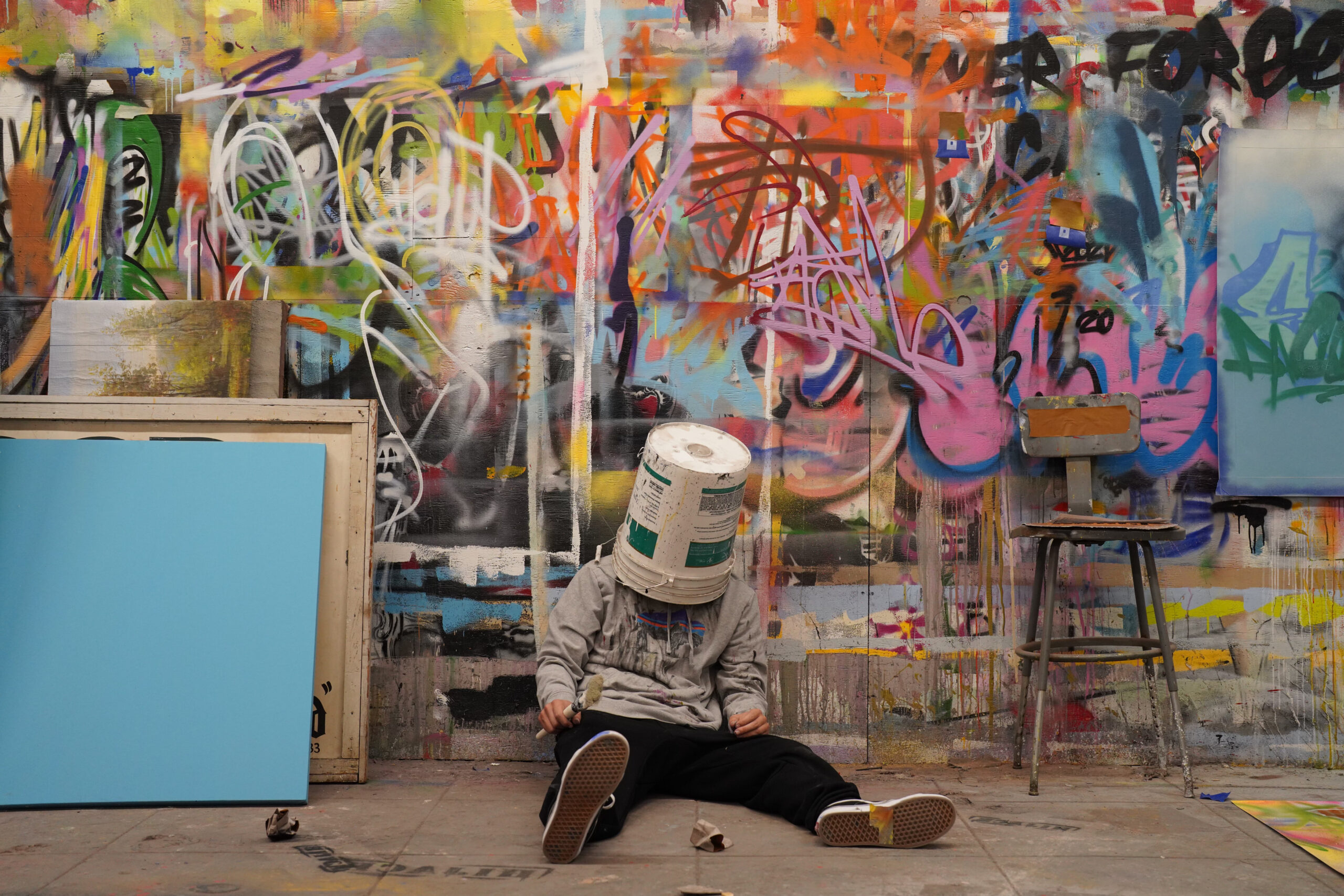
Check out more of Hijack’s art on his website and Instagram.
words. Tessa Swantek


Schön! Magazine is now available in print at Amazon,
as ebook download + on any mobile device












